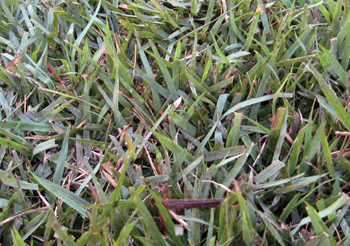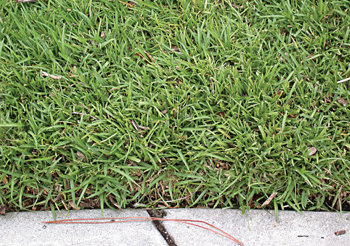
Turfgrass
The Benefits are Numerous
by Lynn Barber / Published Mar 2015

Turfgrass, when healthy and functional, can provide several benefits. These benefits include filtering and removal of contaminants, a reduction in leaching and erosion, and slowing stormwater from moving into water bodies.
There are several Florida-friendly turfgrasses. They include St. Augustinegrass, Zoysia japonica, Bahiagrass, and Centipedegrass. All turfgrasses have positives and negatives; advantages and disadvantages.
St. Augustinegrass has relatively good shade tolerance, performs well in a variety of soil pH, and establishes quickly from sod. This turfgrass has poor wear tolerance, may need additional water, and forms excessive thatch. Thatch is caused by high amounts of irrigation and fertilization. There is a lack of herbicides for grassy weed control and chinch bugs are a challenge to control in most cultivars. The optimal mowing height depends on the cultivar; most are 3.5–4.0 inches. However, the mowing height for dwarf cultivars is 2.0–2.5 inches. St. Augustinegrass is the turfgrass most widely used in Florida.
 Zoysia japonica has a dense growth habit, requires a rotary mower to maintain the low mowing height, is moderately shade tolerant, and can be maintained with less nitrogen than St. Augustinegrass. It does require the same amount of water as St. Augustinegrass, does form thatch, and is susceptible to large patch and hunting billbug. The optimal mowing height depends on the cultivar; most are 1.5–2.5 inches. However, ‘Empire’ mowing height is 2–2.25 inches. Zoysia japonica is becoming more widely used throughout our state.
Zoysia japonica has a dense growth habit, requires a rotary mower to maintain the low mowing height, is moderately shade tolerant, and can be maintained with less nitrogen than St. Augustinegrass. It does require the same amount of water as St. Augustinegrass, does form thatch, and is susceptible to large patch and hunting billbug. The optimal mowing height depends on the cultivar; most are 1.5–2.5 inches. However, ‘Empire’ mowing height is 2–2.25 inches. Zoysia japonica is becoming more widely used throughout our state.
Bahiagrass requires low maintenance, can be established from seed or sod, is tolerant of drought and sandy soils, and resumes growth when watered. It is not wear tolerant, has an open growth habit that allows for weed competition, and produces seedheads in the summer, which appear weedy. Bahiagrass is susceptible to mole crickets. The optimal mowing height is 3.0–4.0 inches. Bahiagrass is used throughout the state.
 Centipedegrass requires minimal amounts of water, survives through drought, grows slowly, and has fewer insect and disease issues than other turfgrasses. It is naturally a pale yellow-green color, has low wear tolerance, does not perform well in alkaline or saline soils, and is susceptible of nematodes and ground pearls. The optimal mowing height is 1.5–2.5 inches. Centipedegrass performs well in Central and Northern Florida. The cultivar ‘Hammock’ performs well in South Florida.
Centipedegrass requires minimal amounts of water, survives through drought, grows slowly, and has fewer insect and disease issues than other turfgrasses. It is naturally a pale yellow-green color, has low wear tolerance, does not perform well in alkaline or saline soils, and is susceptible of nematodes and ground pearls. The optimal mowing height is 1.5–2.5 inches. Centipedegrass performs well in Central and Northern Florida. The cultivar ‘Hammock’ performs well in South Florida.
Turfgrass maintenance includes mowing, watering, and fertilizing. Mowing height differs among turfgrasses. It influences rooting depth. The shorter the cut, the shorter the roots. Mowing turfgrass too short, otherwise known as scalping, can cause plant injury, reduces stress tolerance of root growth, and weakens rooting and soil loss. No more than one-third of the leaf blade should be removed at any one time. Grass clippings should be left on the turfgrass. Doing this will allow you to decrease turfgrass fertilization by one application during the course of a year, from two to three times, to one to two times. Always mow at the highest height recommended for the turfgrass species. Mower blades should be sharp or there will be a ragged cut, which can attract insects and disease. Turfgrass should be mowed when dry. Grass clippings should be blown back into the landscape and not into the street where they can end up in the storm drain. This results in excessive nutrient loading that may harm wildlife, increase pollution, and close beaches.
If your turfgrass area is in the shade, there are ways you can overcome this. You can allow more light, use shade tolerant groundcovers, or create a mulched landscape bed. You can decrease the foot traffic and other traffic in the area and reduce irrigation and nitrogen application. Plants in the shade require less water.
Lynn Barber, Agent
University of Florida/IFAS Extension, Hillsborough County
Lynn Barber, Agent, University of Florida/IFAS Extension, Hillsborough County, is responsible for educating residents on the nine principles of the Florida Friendly Landscaping™ program. These principles include right plant right place, water efficiently, fertilize appropriately, mulch, attract wildlife, manage yard pests responsibly, recycle, reduce stormwater runoff, and protect the waterfront. Barber is past president of the Florida Association of Natural Resource Extension Professionals and has received numerous awards for programming, publications, and television and radio segments. As a Master Gardener, she has given back thousands of hours in environmental horticulture education to the community.
The information contained in this article is from the Green Industries-Best Man-agement Practices (GI-BMP) training, which is a science-based educational program for Green Industry workers (lawn care and landscape maintenance professionals). This training, developed by the Florida Department of Environmental Protection, and endorsed by the pest control industry, is designed to provide corporate, governmental, environmental, and other personnel the Best Management Practices for lawns and landscapes.
The GI-BMP program teaches environmentally safe landscaping practices that help conserve and protect Florida’s ground and surface waters; saves Florida homeowner’s money, time, and effort; increases the beauty of the home landscape; and protects the health of your family, pets, and the environment. The focus of this training is to reduce non-point source pollution resulting from improper fertilization and pesticide application.
Contact your local Exten-sion office’s commercial horticulture agent for additional information in your county or our GI-BMP State Office. For training records, certificates, online or DVD support, and general customer service, contact us by e-mail or phone. E-mail: gi.bmp@ifas.ufl.edu, (352) 273-4517 (English) | (352) 273-4589 (Español / Spanish)
As always, follow the landscape or architectural control procedures in your deed restrictions before making changes. For more information about the nine principles of the Florida-Friendly Landscaping™ Program, or for assistance with gardening-related questions, contact your local Extension office and/or visit the University of Florida website solutionsforyourlife.com or edis.ifas.ufl.edu.


